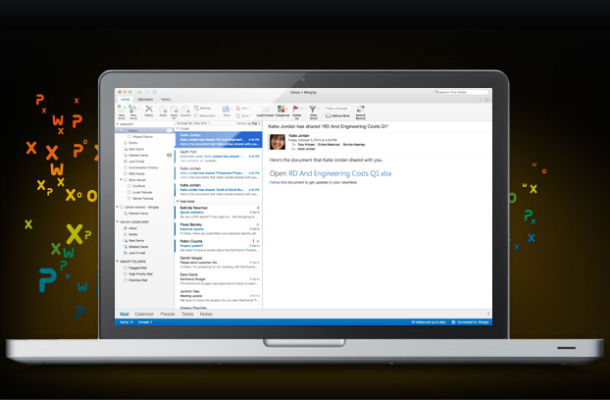Microsoft recently released a new version of Outlook for Mac OS X users, for those with Office 365 subscriptions. Office for Mac was last updated in 2011, marking the first time Mac users had a version of the Outlook mail, calendar scheduling, and contact management application. (The previous equivalent to Outlook for Windows was called Entourage, and Mac users found it lacking in many significant ways.)
The installation instructions for the new Outlook for Mac recommend removing the existing copy of Outlook 2011 before proceeding. This process requires nothing more than throwing the Outlook application in the trash and trashing any reference to it in the Dock. When you download the new version and launch Outlook, it takes several minutes to upgrade existing data from the old version of the software, prompting you to allow it to force quit the Microsoft Database daemon first.

After the new version is up and running, you’re greeted with a new look that includes a new navigation bar along the bottom of the screen to switch between Mail, Calendar, People, Tasks, and Notes. Other new features include weather data displayed inside the Calendar view, the ability to create custom email signatures for new messages and replies, and the ability to work with an online email archive (assuming you’re connected to a Microsoft Exchange mail server with this feature enabled for your account).
 Another notable improvement is support for category sync. In Outlook 2011, custom names and colors used to label items under different categories were locked to your specific computer. Users viewing your shared calendar wouldn’t see the custom labels properly. Now, these items display the same in Outlook for Mac, Outlook for Windows, and in the Outlook web application.
Another notable improvement is support for category sync. In Outlook 2011, custom names and colors used to label items under different categories were locked to your specific computer. Users viewing your shared calendar wouldn’t see the custom labels properly. Now, these items display the same in Outlook for Mac, Outlook for Windows, and in the Outlook web application.
Search functionality gets an overhaul too. Now, searching for text in email is as easy as typing in the search bar and getting a drop-down menu letting you narrow the search by clicking on one of the fields offered.

Unfortunately, beyond these changes and a vague promise that this version is faster and more stable, there doesn’t seem to be a whole lot that’s changed since Outlook 2011. The pull-down menus have essentially the same options as before—notably lacking the Auto Archive functionality of the Windows counterpart that allows automatic copying of older content to a .PST file stored offline.
When displaying multiple calendars, Outlook for Mac still handles them by placing all of the appointments on one calendar on the screen. This is another item I had hoped would be updated to work more like the Windows version, where multiple calendars are displayed in a split-screen view, along side of each other.
Other features missing in action from Outlook 2013 for Windows include support for voting buttons, ability to request a read receipt for a new email, message recall, a Propose New Time option for appointments, and the creation of tables (although existing tables can be copied from Word into Outlook). It doesn’t provide mailbox size and quota information or allow management of Exchange server distribution lists either.
Overall, we’re looking at incrementally improved software, but not a major upgrade. I expected more from a product that’s been neglected for three years. Individuals who own stand-alone copies of Office 2011 probably won’t be able to justify buying an Office 365 subscription just to get the new Outlook. However, corporate users needing to purchase additional Office for Mac licenses anyway as new computers are deployed should strongly consider it. Outlook 2011 has long-limitations with the number of objects (calendar entries, contacts or pieces of email) it handles before becoming unstable and potentially corrupting its database. There’s a good chance that problem has at least partially been addressed with the new version, which could justify its use even if nothing else changed.


Comments are closed.